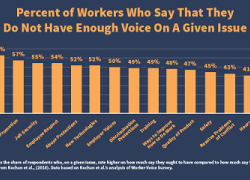
Unions improve the well-being of workers and support the mission of the U.S. Department of Labor in many ways – by improving job security and benefits, strengthening labor-management partnerships and advocating for safer workplaces. Union workers also earn more than their nonunion counterparts and enjoy better benefits. In short, unions have major economic benefits for workers and families.
Following Labor Day, the department is launching the You Have the Right to Form and Join a Union campaign, an effort to inform people of their right to organize a union. Most workers in the private sector, with some exceptions, have the right to form and join a union. Unions are for every worker in every sector, from teachers to retail workers to engineers and more.
As part of this campaign, we’re pleased to share two new resources we hope will help workers understand their right to form a union:
The Worker Organizing Resource and Knowledge Center (WORK Center), developed by the department as part of the White House Taskforce on Worker Organizing and Empowerment, is a brand new one-stop shop to learn:
-
Who has the right to form a union
-
The process for forming a union and negotiating a contract
-
The union advantage in pay, benefits, health and safety, pay equity and more
-
What your employer can and cannot do during a union organizing effort
Worker.gov is a newly updated website about ALL your major workplace rights and your right to not be retaliated against when exercising them, including:
-
Organizing a workers’ committee or a union
-
Voicing safety concerns
-
What to do if you think you may be facing retaliation
There is also a workplace concerns feature that allows you to learn about your rights and how to report or address the issue.
Are you interested in improving your workplace? If so, you may be interested in these downloadable resources:
We hope you find these resources helpful in your community.
Lucia Nunez is a deputy adviser for worker voice engagement. Valeria Treves is a senior adviser for worker voice engagement. Both are in the Department of Labor’s Office of Public Engagement.

 U.S. Department of Labor Blog
U.S. Department of Labor Blog



